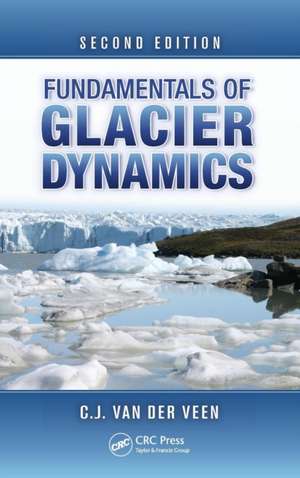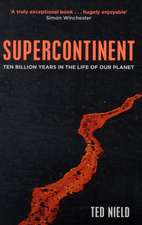Fundamentals of Glacier Dynamics
Autor C.J. van der Veenen Limba Engleză Hardback – 26 mar 2013
See What’s New in the Second Edition:
- Streamlined organization focusing on theory, model development, and data interpretation
- Introductory chapter reviews the most important mathematical tools used throughout the remainder of the book
- New chapter on fracture mechanics and iceberg calving
- Consolidated chapter covers applications of the force-budget technique using measurements of surface velocity to locate mechanical controls on glacier flow
- The latest developments in theory and modeling, including the addition of a discussion of exact time-dependent similarity solutions that can be used for verification of numerical models
Extensively updated with new material and focusing more on presenting the theoretical foundations of glacier flow, the book provides the tools for model validation in the form of analytical steady-state and time-evolving solutions. It provides the necessary background and theoretical foundation for developing more realistic ice-sheet models, which is essential for better integration of data and observations as well as for better model development.
| Toate formatele și edițiile | Preț | Express |
|---|---|---|
| Paperback (1) | 543.05 lei 22-36 zile | +20.85 lei 6-12 zile |
| CRC Press – 29 mar 2017 | 543.05 lei 22-36 zile | +20.85 lei 6-12 zile |
| Hardback (1) | 1554.29 lei 43-57 zile | |
| CRC Press – 26 mar 2013 | 1554.29 lei 43-57 zile |
Preț: 1554.29 lei
Preț vechi: 1895.48 lei
-18% Nou
Puncte Express: 2331
Preț estimativ în valută:
297.51€ • 323.27$ • 250.07£
297.51€ • 323.27$ • 250.07£
Carte tipărită la comandă
Livrare economică 21 aprilie-05 mai
Preluare comenzi: 021 569.72.76
Specificații
ISBN-13: 9781439835661
ISBN-10: 1439835667
Pagini: 404
Ilustrații: 164 black & white illustrations, 40 black & white tables
Dimensiuni: 156 x 234 x 28 mm
Greutate: 0.73 kg
Ediția:Revizuită
Editura: CRC Press
Colecția CRC Press
ISBN-10: 1439835667
Pagini: 404
Ilustrații: 164 black & white illustrations, 40 black & white tables
Dimensiuni: 156 x 234 x 28 mm
Greutate: 0.73 kg
Ediția:Revizuită
Editura: CRC Press
Colecția CRC Press
Public țintă
Graduate students in geophysics and glacier dynamics courses; scientists active in all aspects of glaciology and related research.Cuprins
Mathematical Tools. Ice Deformation. Mechanics of Glacier Flow. Modeling Glacier Flow. Equilibrium Profiles of Glaciers. Glacier Thermodynamics. Subglacial Processes. Fractures. Numerical Ice-Sheet. Models. Dynamics of Glaciers and Ice Sheets. Interpreting Observations. References. Index.
Notă biografică
C. J. van der Veen is a glaciologist interested in the dynamics of fast-moving glaciers and ice streams. His research focuses on using measurements of ice velocity and glacier geometry to identify mechanical controls on glaciers and how changes in these controls affect glacier flow and stability. After completing his PhD at the University of Utrecht in the Netherlands, he spent 20 years at The Ohio State University as a research scientist with the Byrd Polar Research Center (1986–2006). He is currently a professor in the Geography Department and research scientist with the Center for Remote Sensing of Ice Sheets at the University of Kansas.
Recenzii
"In Fundamentals of Glacier Dynamics, Kees van der Veen guides the reader with ease through the different, and sometimes complex, aspects of glacier mechanics. Compared to the first edition, this second revised edition is definitely more focused on ice-dynamical concepts and explains comprehensively the mathematical derivation of stress tensors, deviatoric stresses, invariants, flow laws, glacier and ice stream flow, etc."
—Frank Pattyn, Laboratoire de Glaciologie, Université Libre de Bruxelles, Belgium
"A detailed and timely introduction to the flow and dynamics of glaciers and ice sheets. It will provide excellent guidance to scientists and graduate students for interpreting and modelling the ongoing dramatic changes of alpine and polar ice masses. An impressive book that will stay lie open on my desk."
—Andreas Vieli, Department of Geography, Durham University, UK
"Fundamentals of Glacier Dynamics by Kees van der Veen proceeds logically through the list of topics necessary for a beginning graduate or upper-level undergraduate student to build a strong foundation in glacier dynamics. … Excellent derivations and descriptions are given for the various "end member" models of ice flow … . For students and professionals alike, [this book] serves as a detailed introduction to quantitative glaciology, a reference volume, and an essential companion to Paterson’s classic Physics of Glaciers."
—Stephen Price, Fluid Dynamics and Solid Mechanics Group, Los Alamos National Laboratory
"There is a small and select collection of manuscripts that I keep within arms reach of my desk and this book is one of them. It has a unique place in the catalogue of glaciological texts, providing a thorough treatise on the principles and governing equations that underpin our understanding of ice motion and thermodynamics. … An essential reference text for glaciologists concerned about the flow of ice."
—Jonathan Bamber, Bristol Glaciology Centre, School of Geographical Sciences, University of Bristol, UK
"For years, I have been reaching for C.J. van der Veen 's Fundamentals of Glacier Dynamics when I need substantive and mathematical discussion of ice dynamics. The detailed treatments in the text are ably guided by van der Veen's clear thinking about the fundamentals such as the partitioning of stresses, the energy budget, equilibrium profiles, and the global significance of ice dynamics. Indeed, these fundamentals provide the reader a trail of bread crumbs to guide them through the forest of details that constitute modern glaciology. Now in its second edition, and expanded to include topics such as fracture, I expect that Fundamentals of Glacier Dynamics will continue to be the first text I consult, as well as the one I recommend to students.""
—Jesse Johnson, The University of Montana, USA
"As previously, [this second edition] provides an excellent introduction to glacier and ice sheet dynamics. Being essentially self-contained, it appeals to students from undergraduate to postgraduate level as well as to researchers, both from within the field and from neighboring disciplines. It is indeed an excellent textbook, which I have used a lot when teaching ice dynamics ... [It will] surely be one of the fixed points in the treatments of ice dynamics in the decades to come."
—Nina Kirchner, Stockholm University, Sweden
Praise for the First Edition
"Until now, there has been a growing gap between the relatively introductory treatment of glacier dynamic modeling found in standard texts on glaciology and the large body of research literature. Van der Veen's book does a wonderful service by supplying an approachable, but comprehensive bridge. ... There have been several recent books on glaciers and glacial dynamics and this one is a standout. For any worker who is contemplating modeling or who has to deal with the output of models, this is must have book."
—Neil Humphrey, Department of Geology and Geophysics, University of Wyoming Laramie, USA, Arctic, Antarctic, and Alpine Research, Vol. 34, No. 3, Aug. 2002
"... does an excellent job of presenting our current understanding. ... The back cover recommends the book as suitable for graduate courses in geophysics, and I would endorse this. In addition, it is an excellent refresher for someone like myself who has long experience in glaciology but has read only some of the more recent papers. The author has distilled most of these papers into a very readable volume. ... I see this book as the best of the mathematical bunch, and I would strongly recommend it to established and aspiring glaciologists and to those from other disciplines eager to know just how well—or perhaps how poorly—we understand glaciers and ice sheets."
—Robert H. Thomas, EG&G Services, NASA/Wallops, Wallops Island, Virginia, USA, Eos, Vol. 82, No. 1, Jan. 2, 2001
"What I particularly liked about the book were some fine passages of critical discussion which look at the relationship between theory and observations in some controversial areas. ... It is a better book for people who want to use glaciological theory than either Paterson’s book or Hooke’s book. ... It contains a pretty complete description of ice–climate interactions which is better than anything else in press. If your primary interest is in ice–climate interactions, it would be your best choice as first textbook."
—Richard Hindmarsh, British Antarctic Survey, Cambridge, Earth Surface Processes and Landforms, 26, 2001
"If Paterson’s classic text The physics of glaciers may be considered a bible of modern glaciology, then this recent book by Kees van der Veen is probably one of the newly unearthed gospels. ... Van der Veen is also quite successful at getting across the philosophy of mathematical modelling. ... if your main interest is to acquire the skills to model glacier motion, this book should certainly be high on your shopping list. The more experienced researcher will also find it useful as a reference and teaching aid."
—Felix S.L. Ng, Mathematical Institute, University of Oxford, UK, Journal of Glaciology, Vol. 46, No. 155, 2000
"... this book is best seen as a practical, users' guide to developing the equations and models that describe the physical behaviour of ice masses. As such, it serves as an excellent reference text both to glaciologists and, equally important, to scientists outside the discipline who may wish to familiarise themselves with state-of-the-art numerical glaciology. Topics and treatments are introduced from their fundamental principles and developed quantitatively at a level that can be followed by readers with mathematics or physics to undergraduate level. ... Fundamentals of glacier dynamics is a well-written and well-produced text which is fair value. ... To summarise, this is a very useful book to those with some mathematical ability and who have an interest in the quantitative description and modelling of ice dynamics."
—Bryn Hubbard, Polar Record, Vol. 36, Issue 199, October 2000
—Frank Pattyn, Laboratoire de Glaciologie, Université Libre de Bruxelles, Belgium
"A detailed and timely introduction to the flow and dynamics of glaciers and ice sheets. It will provide excellent guidance to scientists and graduate students for interpreting and modelling the ongoing dramatic changes of alpine and polar ice masses. An impressive book that will stay lie open on my desk."
—Andreas Vieli, Department of Geography, Durham University, UK
"Fundamentals of Glacier Dynamics by Kees van der Veen proceeds logically through the list of topics necessary for a beginning graduate or upper-level undergraduate student to build a strong foundation in glacier dynamics. … Excellent derivations and descriptions are given for the various "end member" models of ice flow … . For students and professionals alike, [this book] serves as a detailed introduction to quantitative glaciology, a reference volume, and an essential companion to Paterson’s classic Physics of Glaciers."
—Stephen Price, Fluid Dynamics and Solid Mechanics Group, Los Alamos National Laboratory
"There is a small and select collection of manuscripts that I keep within arms reach of my desk and this book is one of them. It has a unique place in the catalogue of glaciological texts, providing a thorough treatise on the principles and governing equations that underpin our understanding of ice motion and thermodynamics. … An essential reference text for glaciologists concerned about the flow of ice."
—Jonathan Bamber, Bristol Glaciology Centre, School of Geographical Sciences, University of Bristol, UK
"For years, I have been reaching for C.J. van der Veen 's Fundamentals of Glacier Dynamics when I need substantive and mathematical discussion of ice dynamics. The detailed treatments in the text are ably guided by van der Veen's clear thinking about the fundamentals such as the partitioning of stresses, the energy budget, equilibrium profiles, and the global significance of ice dynamics. Indeed, these fundamentals provide the reader a trail of bread crumbs to guide them through the forest of details that constitute modern glaciology. Now in its second edition, and expanded to include topics such as fracture, I expect that Fundamentals of Glacier Dynamics will continue to be the first text I consult, as well as the one I recommend to students.""
—Jesse Johnson, The University of Montana, USA
"As previously, [this second edition] provides an excellent introduction to glacier and ice sheet dynamics. Being essentially self-contained, it appeals to students from undergraduate to postgraduate level as well as to researchers, both from within the field and from neighboring disciplines. It is indeed an excellent textbook, which I have used a lot when teaching ice dynamics ... [It will] surely be one of the fixed points in the treatments of ice dynamics in the decades to come."
—Nina Kirchner, Stockholm University, Sweden
Praise for the First Edition
"Until now, there has been a growing gap between the relatively introductory treatment of glacier dynamic modeling found in standard texts on glaciology and the large body of research literature. Van der Veen's book does a wonderful service by supplying an approachable, but comprehensive bridge. ... There have been several recent books on glaciers and glacial dynamics and this one is a standout. For any worker who is contemplating modeling or who has to deal with the output of models, this is must have book."
—Neil Humphrey, Department of Geology and Geophysics, University of Wyoming Laramie, USA, Arctic, Antarctic, and Alpine Research, Vol. 34, No. 3, Aug. 2002
"... does an excellent job of presenting our current understanding. ... The back cover recommends the book as suitable for graduate courses in geophysics, and I would endorse this. In addition, it is an excellent refresher for someone like myself who has long experience in glaciology but has read only some of the more recent papers. The author has distilled most of these papers into a very readable volume. ... I see this book as the best of the mathematical bunch, and I would strongly recommend it to established and aspiring glaciologists and to those from other disciplines eager to know just how well—or perhaps how poorly—we understand glaciers and ice sheets."
—Robert H. Thomas, EG&G Services, NASA/Wallops, Wallops Island, Virginia, USA, Eos, Vol. 82, No. 1, Jan. 2, 2001
"What I particularly liked about the book were some fine passages of critical discussion which look at the relationship between theory and observations in some controversial areas. ... It is a better book for people who want to use glaciological theory than either Paterson’s book or Hooke’s book. ... It contains a pretty complete description of ice–climate interactions which is better than anything else in press. If your primary interest is in ice–climate interactions, it would be your best choice as first textbook."
—Richard Hindmarsh, British Antarctic Survey, Cambridge, Earth Surface Processes and Landforms, 26, 2001
"If Paterson’s classic text The physics of glaciers may be considered a bible of modern glaciology, then this recent book by Kees van der Veen is probably one of the newly unearthed gospels. ... Van der Veen is also quite successful at getting across the philosophy of mathematical modelling. ... if your main interest is to acquire the skills to model glacier motion, this book should certainly be high on your shopping list. The more experienced researcher will also find it useful as a reference and teaching aid."
—Felix S.L. Ng, Mathematical Institute, University of Oxford, UK, Journal of Glaciology, Vol. 46, No. 155, 2000
"... this book is best seen as a practical, users' guide to developing the equations and models that describe the physical behaviour of ice masses. As such, it serves as an excellent reference text both to glaciologists and, equally important, to scientists outside the discipline who may wish to familiarise themselves with state-of-the-art numerical glaciology. Topics and treatments are introduced from their fundamental principles and developed quantitatively at a level that can be followed by readers with mathematics or physics to undergraduate level. ... Fundamentals of glacier dynamics is a well-written and well-produced text which is fair value. ... To summarise, this is a very useful book to those with some mathematical ability and who have an interest in the quantitative description and modelling of ice dynamics."
—Bryn Hubbard, Polar Record, Vol. 36, Issue 199, October 2000
Descriere
The Intergovernmental Panel on Climate Change Fourth Assessment Report (2007) acknowledged that current ice sheet models do not adequately treat the dynamic response of ice sheets to climate change. This second edition addresses these issues through the addition of new chapters covering glacier instabilities, the interpretation of observations, and ice sheets and sea level. Another new chapter covers glacier mass balance. The text also provides the necessary background and theoretical foundation for developing more realistic ice sheet models, which is essential for better integration of data and observations as well as for better model development.















